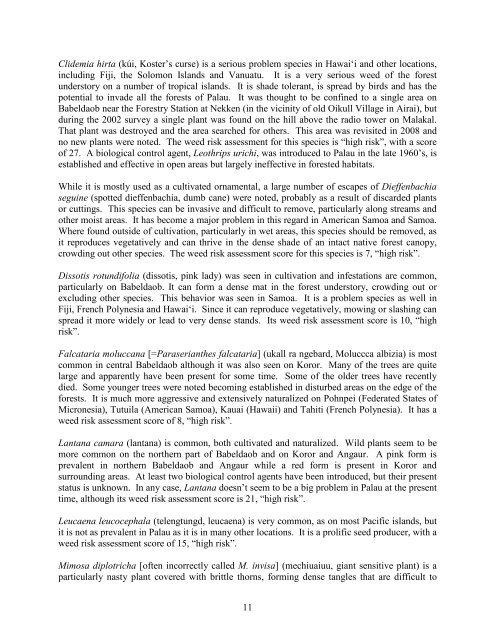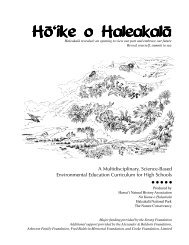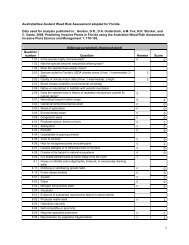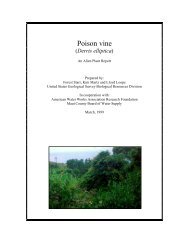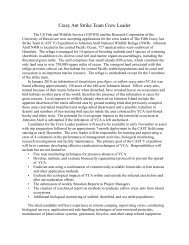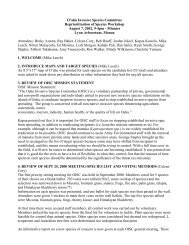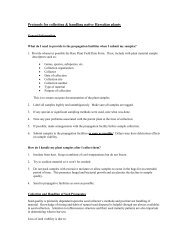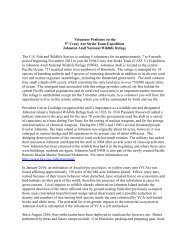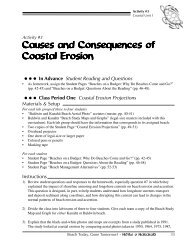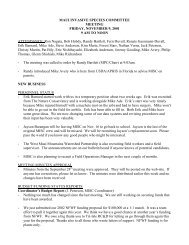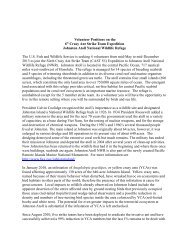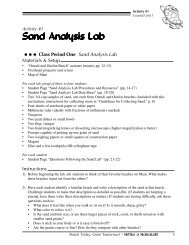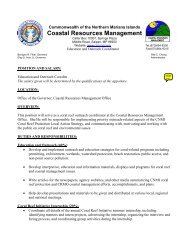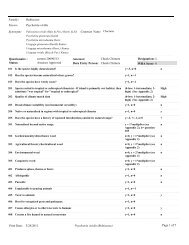Report to the Republic of Palau: 2008 update on Invasive Plant ...
Report to the Republic of Palau: 2008 update on Invasive Plant ...
Report to the Republic of Palau: 2008 update on Invasive Plant ...
You also want an ePaper? Increase the reach of your titles
YUMPU automatically turns print PDFs into web optimized ePapers that Google loves.
Clidemia hirta (kúi, Koster’s curse) is a serious problem species in Hawai‘i and o<str<strong>on</strong>g>the</str<strong>on</strong>g>r locati<strong>on</strong>s,<br />
including Fiji, <str<strong>on</strong>g>the</str<strong>on</strong>g> Solom<strong>on</strong> Islands and Vanuatu. It is a very serious weed <str<strong>on</strong>g>of</str<strong>on</strong>g> <str<strong>on</strong>g>the</str<strong>on</strong>g> forest<br />
unders<str<strong>on</strong>g>to</str<strong>on</strong>g>ry <strong>on</strong> a number <str<strong>on</strong>g>of</str<strong>on</strong>g> tropical islands. It is shade <str<strong>on</strong>g>to</str<strong>on</strong>g>lerant, is spread by birds and has <str<strong>on</strong>g>the</str<strong>on</strong>g><br />
potential <str<strong>on</strong>g>to</str<strong>on</strong>g> invade all <str<strong>on</strong>g>the</str<strong>on</strong>g> forests <str<strong>on</strong>g>of</str<strong>on</strong>g> <str<strong>on</strong>g>Palau</str<strong>on</strong>g>. It was thought <str<strong>on</strong>g>to</str<strong>on</strong>g> be c<strong>on</strong>fined <str<strong>on</strong>g>to</str<strong>on</strong>g> a single area <strong>on</strong><br />
Babeldaob near <str<strong>on</strong>g>the</str<strong>on</strong>g> Forestry Stati<strong>on</strong> at Nekken (in <str<strong>on</strong>g>the</str<strong>on</strong>g> vicinity <str<strong>on</strong>g>of</str<strong>on</strong>g> old Oikull Village in Airai), but<br />
during <str<strong>on</strong>g>the</str<strong>on</strong>g> 2002 survey a single plant was found <strong>on</strong> <str<strong>on</strong>g>the</str<strong>on</strong>g> hill above <str<strong>on</strong>g>the</str<strong>on</strong>g> radio <str<strong>on</strong>g>to</str<strong>on</strong>g>wer <strong>on</strong> Malakal.<br />
That plant was destroyed and <str<strong>on</strong>g>the</str<strong>on</strong>g> area searched for o<str<strong>on</strong>g>the</str<strong>on</strong>g>rs. This area was revisited in <str<strong>on</strong>g>2008</str<strong>on</strong>g> and<br />
no new plants were noted. The weed risk assessment for this species is “high risk”, with a score<br />
<str<strong>on</strong>g>of</str<strong>on</strong>g> 27. A biological c<strong>on</strong>trol agent, Leothrips urichi, was introduced <str<strong>on</strong>g>to</str<strong>on</strong>g> <str<strong>on</strong>g>Palau</str<strong>on</strong>g> in <str<strong>on</strong>g>the</str<strong>on</strong>g> late 1960’s, is<br />
established and effective in open areas but largely ineffective in forested habitats.<br />
While it is mostly used as a cultivated ornamental, a large number <str<strong>on</strong>g>of</str<strong>on</strong>g> escapes <str<strong>on</strong>g>of</str<strong>on</strong>g> Dieffenbachia<br />
seguine (spotted dieffenbachia, dumb cane) were noted, probably as a result <str<strong>on</strong>g>of</str<strong>on</strong>g> discarded plants<br />
or cuttings. This species can be invasive and difficult <str<strong>on</strong>g>to</str<strong>on</strong>g> remove, particularly al<strong>on</strong>g streams and<br />
o<str<strong>on</strong>g>the</str<strong>on</strong>g>r moist areas. It has become a major problem in this regard in American Samoa and Samoa.<br />
Where found outside <str<strong>on</strong>g>of</str<strong>on</strong>g> cultivati<strong>on</strong>, particularly in wet areas, this species should be removed, as<br />
it reproduces vegetatively and can thrive in <str<strong>on</strong>g>the</str<strong>on</strong>g> dense shade <str<strong>on</strong>g>of</str<strong>on</strong>g> an intact native forest canopy,<br />
crowding out o<str<strong>on</strong>g>the</str<strong>on</strong>g>r species. The weed risk assessment score for this species is 7, “high risk”.<br />
Dissotis rotundifolia (dissotis, pink lady) was seen in cultivati<strong>on</strong> and infestati<strong>on</strong>s are comm<strong>on</strong>,<br />
particularly <strong>on</strong> Babeldaob. It can form a dense mat in <str<strong>on</strong>g>the</str<strong>on</strong>g> forest unders<str<strong>on</strong>g>to</str<strong>on</strong>g>ry, crowding out or<br />
excluding o<str<strong>on</strong>g>the</str<strong>on</strong>g>r species. This behavior was seen in Samoa. It is a problem species as well in<br />
Fiji, French Polynesia and Hawai‘i. Since it can reproduce vegetatively, mowing or slashing can<br />
spread it more widely or lead <str<strong>on</strong>g>to</str<strong>on</strong>g> very dense stands. Its weed risk assessment score is 10, “high<br />
risk”.<br />
Falcataria moluccana [=Paraserian<str<strong>on</strong>g>the</str<strong>on</strong>g>s falcataria] (ukall ra ngebard, Moluccca albizia) is most<br />
comm<strong>on</strong> in central Babeldaob although it was also seen <strong>on</strong> Koror. Many <str<strong>on</strong>g>of</str<strong>on</strong>g> <str<strong>on</strong>g>the</str<strong>on</strong>g> trees are quite<br />
large and apparently have been present for some time. Some <str<strong>on</strong>g>of</str<strong>on</strong>g> <str<strong>on</strong>g>the</str<strong>on</strong>g> older trees have recently<br />
died. Some younger trees were noted becoming established in disturbed areas <strong>on</strong> <str<strong>on</strong>g>the</str<strong>on</strong>g> edge <str<strong>on</strong>g>of</str<strong>on</strong>g> <str<strong>on</strong>g>the</str<strong>on</strong>g><br />
forests. It is much more aggressive and extensively naturalized <strong>on</strong> Pohnpei (Federated States <str<strong>on</strong>g>of</str<strong>on</strong>g><br />
Micr<strong>on</strong>esia), Tutuila (American Samoa), Kauai (Hawaii) and Tahiti (French Polynesia). It has a<br />
weed risk assessment score <str<strong>on</strong>g>of</str<strong>on</strong>g> 8, “high risk”.<br />
Lantana camara (lantana) is comm<strong>on</strong>, both cultivated and naturalized. Wild plants seem <str<strong>on</strong>g>to</str<strong>on</strong>g> be<br />
more comm<strong>on</strong> <strong>on</strong> <str<strong>on</strong>g>the</str<strong>on</strong>g> nor<str<strong>on</strong>g>the</str<strong>on</strong>g>rn part <str<strong>on</strong>g>of</str<strong>on</strong>g> Babeldaob and <strong>on</strong> Koror and Angaur. A pink form is<br />
prevalent in nor<str<strong>on</strong>g>the</str<strong>on</strong>g>rn Babeldaob and Angaur while a red form is present in Koror and<br />
surrounding areas. At least two biological c<strong>on</strong>trol agents have been introduced, but <str<strong>on</strong>g>the</str<strong>on</strong>g>ir present<br />
status is unknown. In any case, Lantana doesn’t seem <str<strong>on</strong>g>to</str<strong>on</strong>g> be a big problem in <str<strong>on</strong>g>Palau</str<strong>on</strong>g> at <str<strong>on</strong>g>the</str<strong>on</strong>g> present<br />
time, although its weed risk assessment score is 21, “high risk”.<br />
Leucaena leucocephala (telengtungd, leucaena) is very comm<strong>on</strong>, as <strong>on</strong> most Pacific islands, but<br />
it is not as prevalent in <str<strong>on</strong>g>Palau</str<strong>on</strong>g> as it is in many o<str<strong>on</strong>g>the</str<strong>on</strong>g>r locati<strong>on</strong>s. It is a prolific seed producer, with a<br />
weed risk assessment score <str<strong>on</strong>g>of</str<strong>on</strong>g> 15, “high risk”.<br />
Mimosa diplotricha [<str<strong>on</strong>g>of</str<strong>on</strong>g>ten incorrectly called M. invisa] (mechiuaiuu, giant sensitive plant) is a<br />
particularly nasty plant covered with brittle thorns, forming dense tangles that are difficult <str<strong>on</strong>g>to</str<strong>on</strong>g><br />
11


